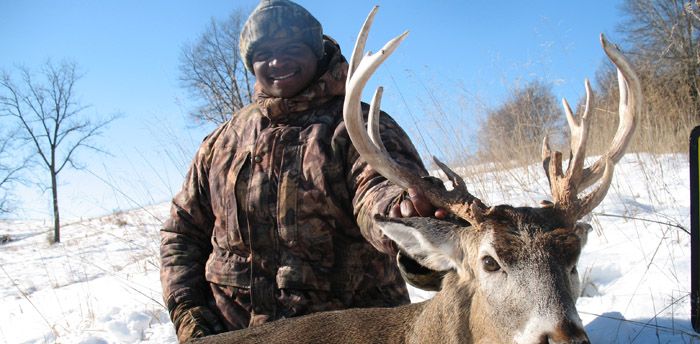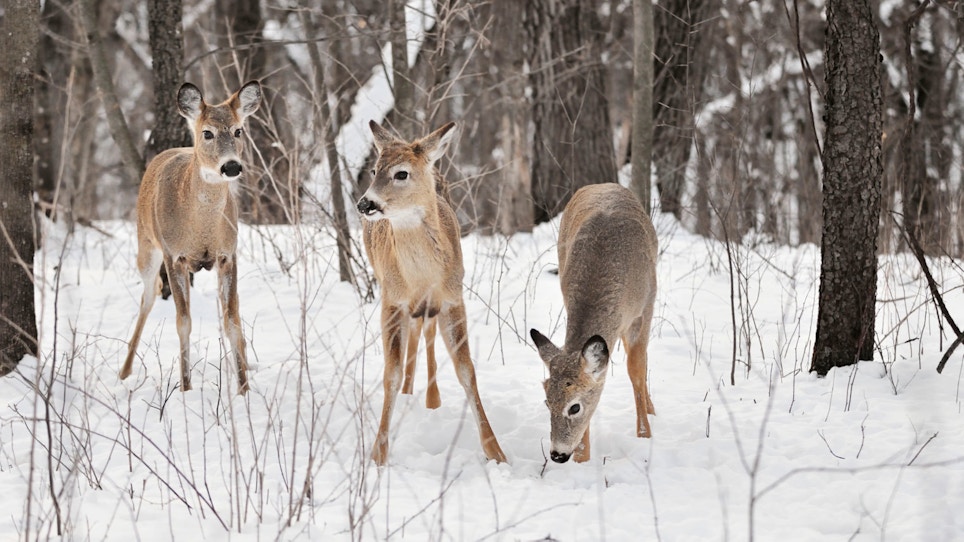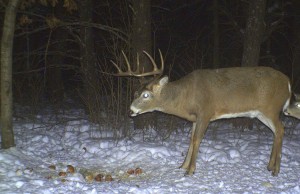Deer don’t hibernate like some mammals, so how do they survive brutal winters?
Several years ago, while deer hunting in Alberta, I experienced some of the nastiest weather I’ve ever seen. High winds, continual snow, and worst of all, extremely cold, subzero weather. With winds so strong I could not shoot a bow, I holed up in the lodge.
While talking to my guide, I asked how much of this kind of weather they had in that part of the world and found out that such weather was common, often for weeks at a time. I marveled that deer could survive in those conditions and wondered how they did it. Not all make it through bad winters, but most do.
Winter weather is made up of many things. Temperature and wind are two obvious factors, as are cloud cover, dew point, humidity, barometric pressure, wind chill, thermal currents and precipitation amounts. They all create what we know as “cold.”
In the Midwest, whitetails get hit with some major winter weather but it doesn’t usually drag on for months at a time. There are exceptions, such as the winter of 2007 when deep snows and bitter cold killed lots of deer in eastern Montana and North Dakota. Further north, brutal winters are the norm. Some small mammals avoid such weather by hibernating. Black bears, though not true hibernators, lower their metabolism and remain sedentary during the worst cold.
Deer do not have those options. We know what deer hunters do to deal with cold weather, but what do deer do? How do they survive nasty winter weather?

Hunters have the advantage of great apparel and boots but deer have to make the most of their fat reserves and battle the elements.
Whitetail survival is due to several things
Let’s eliminate some simple adaptations first. As with all mammals, body size of deer increases as you move north. Larger bodies mean a lower surface-to-mass ratio and this conserves energy. Deer also shed their lighter summer coat for a heavier winter coat composed of hollow hair shafts and a dense underfur. Both adaptations provide added insulation. Deer have special skin muscles that allow them to adjust the angle of the hair shafts to provide the best insulation.
I love reading The Deer-Forest Blog; Google The Deer-Forest Blog to register for their weekly blogs on deer research being done at Penn State University. They are entertaining and informative, and you will continually find information that will improve your deer hunting.
Every hunter knows in autumn deer prepare for winter by eating more to add layers of fat. Those fat reserves are critical during the winter. Once winter hits, deer have stored about 25 percent of their body weight as fat. One of the Deer-Forest blogs presented data on weights of bucks and does from October through the winter. Pennsylvania bucks reach their maximum weight by Oct. 1. No wonder the acorn mast they consume in September is so important.
After Oct. 1, bucks lost a lot of weight through the rut and winter. By March they start to gain weight again. Does do the same, but they reach their maximum weight about Jan. 1 before showing a decrease. What this means is that bucks rely on fat reserves almost twice as long as does before spring arrives. The Deer-Forest Blog authors suggest this is why bucks are more susceptible to starvation than does in bad winters.
What other factors help with deer survival?
Those are some of the major strategies that get deer through bad winter, but there are others. When a deer is at rest, its metabolic rate varies depending on the season. You might think in winter this rate would increase to allow the deer to stay warm, but the opposite is true. The metabolic rate decreases in winter. Recent research from Europe on red deer shows that red deer reduce their heart rate even more if they aren’t getting enough food.
There is more to this, with reportedly a direct correlation between heart rate and rumen temperature. When things get really tough, deer lower their heart rate and body temperature, which reduces energy expenditure. (The resting heart rate of a deer is 40-50 beats per minute. Ours is slightly higher, although great runners have resting heart rates below 50 beats per minute.) The European researchers answered the question of whether they are deliberately conserving energy, or are these changes a result of the fact that there is little food to eat?
It turns out no matter how much food the red deer ate, even those that received lots of high protein in their diet showed lower heart rates in the winter. Heart rates of 65 beats per minute in spring fell to 40 in the winter. Therefore, deer automatically decreased their metabolism in winter, no matter how much food was available. That makes sense, especially when there is deep snow. In those conditions it takes a lot of energy to get the available food, probably more than the food provides them. So, lower temperature in the legs and the ears slows down body functions such as digestion, yet they survive.
When winter conditions are bad in northern deer habitat in Maine, Michigan, Minnesota and elsewhere, deer will “yard” up. Deer yard habitat is where deer go to avoid winter winds and deep snows. They will move very little and remain for one to three months. Valley bottoms with conifer cover make good yards for deer. Cedar, hemlock, fir or spruce help shield deer from snow, and it is said that such habitat has 40 percent less snow than hardwood forests.
As deer lower their energy expenditure, even if there is limited food their body weight turns around and starts to increase in late winter. Yes, you read that correctly. The red deer research showed that a huge increase in weight occurred in red deer in the spring, even with little change in the daily intake of food. I believe our whitetails may have that same internal clock telling them to slow down everything in winter. When spring comes, the weight comes back.
When you see deer on winter food plots eating a lot, but appear to have lost weight, now you may know why. It is all about the feeding strategy and metabolism. The question for the deer is, do I want to expend more energy to find food and digest it than the food is worth to me?
Apparently, over time, the deer have figured it out. Just eat enough to keep alive, move very little and make it through the winter. But two factors can change that strategy for deer and cause mortality. One is food availability in autumn. Long summer droughts can diminish available food for deer when they need to build fat reserves. Second, how long and how nasty is the winter? Cold temperatures and deep snows that start early and last beyond normal into spring can cause mortality.
In fact, that is why on rare occasions, some state game agencies will put out feed for deer. All state wildlife agencies discourage citizens from feeding deer in winter. However, there are rare winters when the snow is so deep and the weather so cold for long periods that deer survival is in question. When this happens, some wildlife agencies will put out feed.
Deer know what to do in winter. Those strategies work, for the most part, without our help. Cold weather has a lot less impact on hunters because of the clothing technology that has produced such warm products.
Obviously, deer do not have the advantage of heated socks and hand warmers and the aforementioned clothing. No question, when you look at winter weather from a deer’s perspective, on those brutal cold days on stand, we as humans have it pretty easy.







